MSI X79A-GD45 Plus Review: Building Up
by Ian Cutress on February 14, 2014 10:00 AM EST- Posted in
- Motherboards
- Intel
- MSI
- X79
Real World CPU Benchmarks
Readers of our motherboard review section will have noted the trend in modern motherboards to implement a form of MultiCore Enhancement / Acceleration / Turbo (read our report here) on their motherboards. This does several things – better benchmark results at stock settings (not entirely needed if overclocking is an end-user goal), at the expense of heat and temperature, but also gives in essence an automatic overclock which may be against what the user wants. Our testing methodology is ‘out-of-the-box’, with the latest public BIOS installed and XMP enabled, and thus subject to the whims of this feature. It is ultimately up to the motherboard manufacturer to take this risk – and manufacturers taking risks in the setup is something they do on every product (think C-state settings, USB priority, DPC Latency / monitoring priority, memory subtimings at JEDEC). Processor speed change is part of that risk which is clearly visible, and ultimately if no overclocking is planned, some motherboards will affect how fast that shiny new processor goes and can be an important factor in the purchase.
For reference, the MSI X79A-GD45 does enable MCT when XMP is enabled.
Rendering – Adobe After Effects CS6: link
Published by Adobe, After Effects is a digital motion graphics, visual effects and compositing software package used in the post-production process of filmmaking and television production. For our benchmark we downloaded a common scene in use on the AE forums for benchmarks and placed it under our own circumstances for a repeatable benchmark. We generate 152 frames of the scene and present the time to do so based purely on CPU calculations.

Compression – WinRAR 5.0.1: link
Our WinRAR test from 2013 is updated to the latest version of WinRAR at the start of 2014. We compress a set of 2867 files across 320 folders totaling 1.52 GB in size – 95% of these files are small typical website files, and the rest (90% of the size) are small 30 second 720p videos.
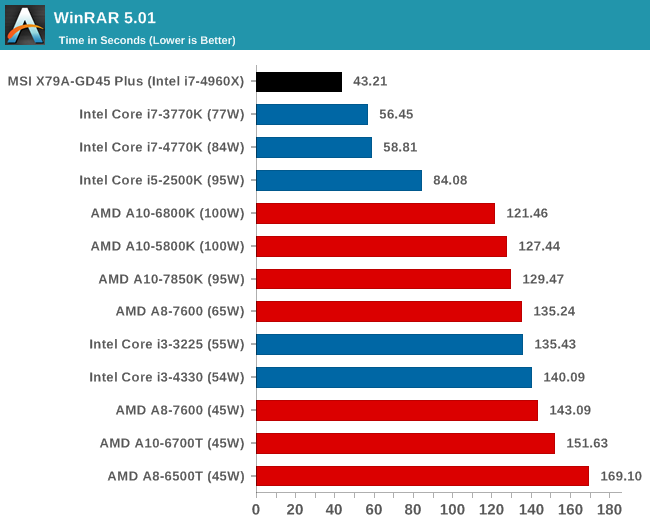
Image Manipulation – FastStone Image Viewer 4.9: link
Similarly to WinRAR, the FastStone test us updated for 2014 to the latest version. FastStone is the program I use to perform quick or bulk actions on images, such as resizing, adjusting for color and cropping. In our test we take a series of 170 images in various sizes and formats and convert them all into 640x480 .gif files, maintaining the aspect ratio. FastStone does not use multithreading for this test, and thus single threaded performance is often the winner.
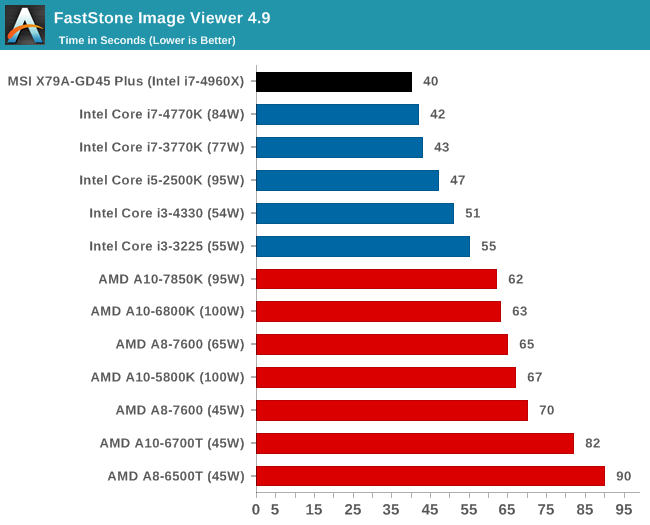
Video Conversion – Xilisoft Video Converter 7: link
The XVC test I normally do is updated to the full version of the software, and this time a different test as well. Here we take two different videos: a double UHD (3840x4320) clip of 10 minutes and a 640x266 DVD rip of a 2h20 film and convert both to iPod suitable formats. The reasoning here is simple – when frames are small enough to fit into memory, the algorithm has more chance to apply work between threads and process the video quicker. Results shown are in seconds and time taken to encode.
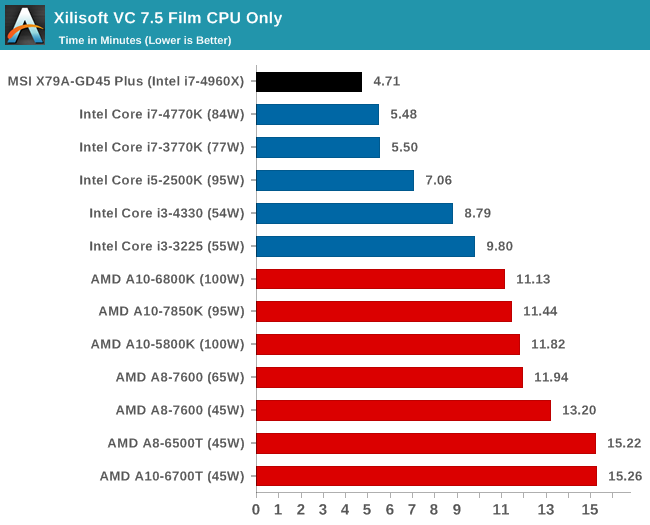
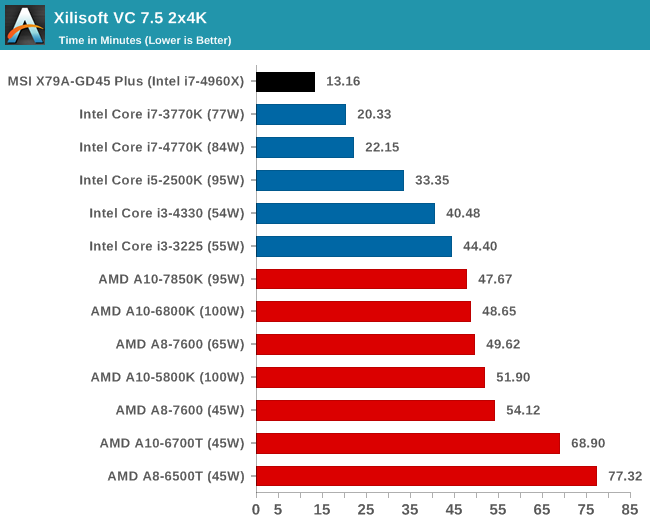
Video Conversion – Handbrake v0.9.9: link
Handbrake is a media conversion tool that was initially designed to help DVD ISOs and Video CDs into more common video formats. The principle today is still the same, primarily as an output for H.264 + AAC/MP3 audio within an MKV container. In our test we use the same videos as in the Xilisoft test, and results are given in frames per second.
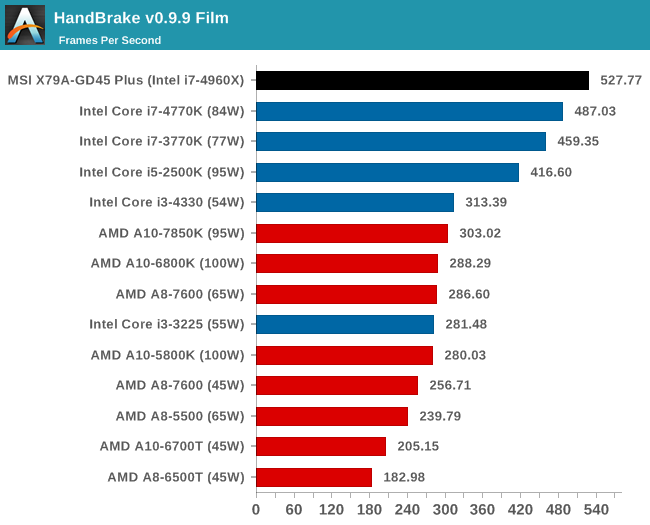
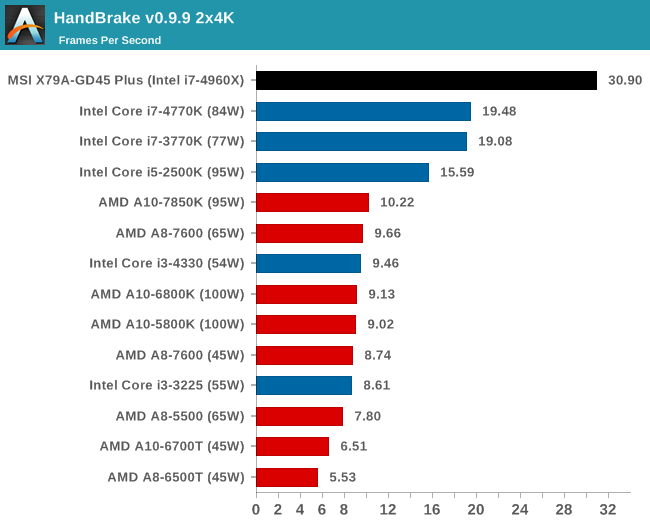
Rendering – PovRay 3.7: link
The Persistence of Vision RayTracer, or PovRay, is a freeware package for as the name suggests, ray tracing. It is a pure renderer, rather than modeling software, but the latest beta version contains a handy benchmark for stressing all processing threads on a platform. We have been using this test in motherboard reviews to test memory stability at various CPU speeds to good effect – if it passes the test, the IMC in the CPU is stable for a given CPU speed. As a CPU test, it runs for approximately 2-3 minutes on high end platforms.
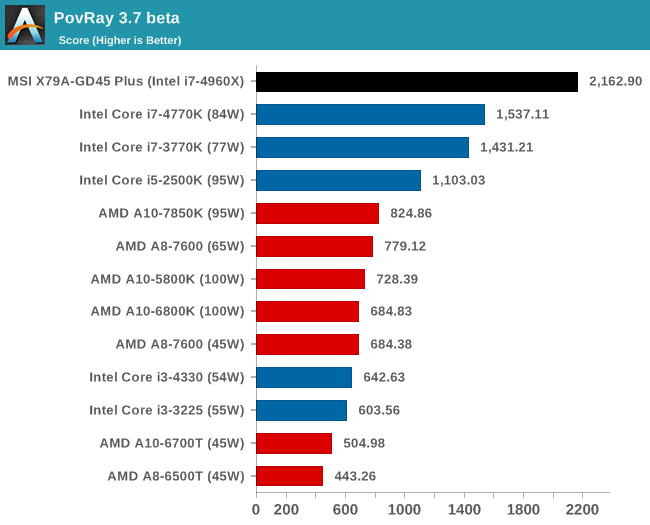










44 Comments
View All Comments
hulu - Friday, February 14, 2014 - link
In Board Features > Memory Slots, says "Up to Dual Channel". Shouldn't it be quad channel?dgingeri - Friday, February 14, 2014 - link
Well, it could be useful for a high level home server with that many slots. Put a low end video card in the top, raid controller in the second, quad port 1Gb NICs in the 4th and 5th, and have the last slot available for a 10Gb card if needed. Wouldn't even need a switch to go with it. All in one, storage, network, routing, high end network. It has possibilities.Rick83 - Friday, February 14, 2014 - link
But most of that you can do with 1155, and for that price you can get a board with ECC support to boot, won't need any GPU at all (unless you get a Xeon that has the GPU disabled), and still have plenty room to grow. 1155 has plenty of PCIe bandwidth, as long as most of your load is from two expansion slots. Hooking up RAID and networking directly to the CPU means that you will have two or three expansion cards that may eventually be bandwidth restrained, but even then opting for a board with a PCIe MUX would be in the same league, price-wise as this, and have plenty of bandwidth for up to four cards - and most non-GPU cards aren't really PCIe restricted. Quad GbE is one lane PCIe3, 10GbE is 2-4 lanes, 8x 6Gb SAS with software RAID over SSDs is going to need 8x PCIeV3, but realistically 4x is going to be enough, if you use hardware RAID or spinning platters.No, the only reason for this board, is if you want a cheap rendering machine. 6-8 cores and 64GB of RAM on a 250 dollar board is pretty nice. If you want gaming, you'll probably be looking at boards higher up the foodchain, as the GPUs alone will come in at around 2-3k dollars, and another 100 on the board won't really matter, if you get better sound and other nifty features.
GPU computer might be another use case, but then that's even rarer than rendering boxes, from what I've seen so far. Might be a nice little GPU compute dev workstation.
Flunk - Friday, February 14, 2014 - link
There really isn't any need for this as a home server. It's total overkill. Even a Core 2 Quad can transcode multiple 1080p streams while serving files, routing and doing all the other common home server tasks. Home servers don't really need much power, most homes don't have more than 4-6 users.dgingeri - Friday, February 14, 2014 - link
For total I/O and a poor man's 10Gbe switch, socket 2011 or 1366 can't be beat. That's what I mostly use my home servers for. Socket 775, 1155, or 1150 systems simply can't provide the I/O to run a software switch that includes 10Gbe.Yeah, sure, 10Gbe is hardly worth the expense in a home server. However, with a raid controller and quad drive set capable of pushing 400MB/s, it can be useful for video editing over a network drive, or a few other things.
I do it as an experiment on future uses and self training. Right now, I have three servers interconnected with 10Gb over such a poor man's 10Gbe switch running a total of 14 VMs over 3 domains with 6 domain controllers, 3 WDS servers, and some 'workstations', just to prove I could do it before I propose doing the same thing with the DNS servers in my lab. (We currently have 4 domains across 17 departments, with 3 of those 4 running Linux DNS servers that don't talk to each other. It's really annoying working on machines that cross those domains. So, I had to come up with a plan to fix it with Windows DNS and AD, and eventually migrate down to one domain. In addition, I was to come up with a way to manage user accounts through Windows AD for a single centralized vCenter server to manage our test VM hosts. I wasn't sure I could do it until I spent a weekend building all these VMs.) All of those VMs are running on iSCSI storage over 10Gbe from the storage server. I did all this with two Dell T110 II servers, one for storage and one for routing/switch, and a piecemeal FX-6100 VM host and 4 Intel CX4 10Gbe NICs.
In essence, I was just dreaming about a more capable central server for my experiments when I posted that previous comment. I could switch the storage and switch duties to a system with this board and use the Dells as further VM hosts. Maybe I'm just spoiled with all this hardware at work.
Ian Cutress - Friday, February 14, 2014 - link
Copy/Paste error from my spec tables which I hand code to make it easier :) Should be fixed.Ian
Bal - Friday, February 14, 2014 - link
Ok I am not one to criticize articles, but this reads REALLY poorly. I mean I am the guy who misspells every other word and uses slang, misses apostrophes etc. So I forgive everything as long as its readable. But I could not get past the first page of this review.The writer misuses "are" and "is" so often I have to reread every other sentence. He completely misses using the word "the" and it also makes you reread each sentence. Read the first two paragraphs and someone tell me I am wrong? Am I just grumpy, hungover or what?
The PC Apologist - Friday, February 14, 2014 - link
Hahaha, you must be new to Ian. He's rather infamous for his "style."It would seem that eloquence is not as valued as passion when it comes to the tech journalism industry, even for Anandtech. Refer to the 14 AIO coolers article and its comments section to see an excellent example of what I mean. There I had a little exchange with the author and boy, it’s not pretty.
Although one could say that one doesn’t read a motherboard review, or any other tech article, to brush up on one’s English grammar or writing skills, but rather just to look at some pretty pictures, learn the price/specs, and read the conclusion, it’s somewhat of a weak cop-out as one would also expect AnandTech to strive for higher standards. Reading is reading and a poorly written article is a poorly written article, regardless of topic. Other sites aren’t much better though. And to their defense, there are some decent writers, in terms of pure writing, here at AnandTech, not least of which is Anand himself. And who knows? I might even answer AnandTech’s Call for Writers one of these days. So fret not, all hope is not lost.
- The PC Apologist
thesavvymage - Saturday, February 15, 2014 - link
I would absolutely loathe you writing for this site. I'm sure the other writers would hate you writing with them as well, pretty much every time I see you in the comments it is because you are complaining of the competence of the english and grammar of the article.BlakKW - Saturday, February 15, 2014 - link
+1